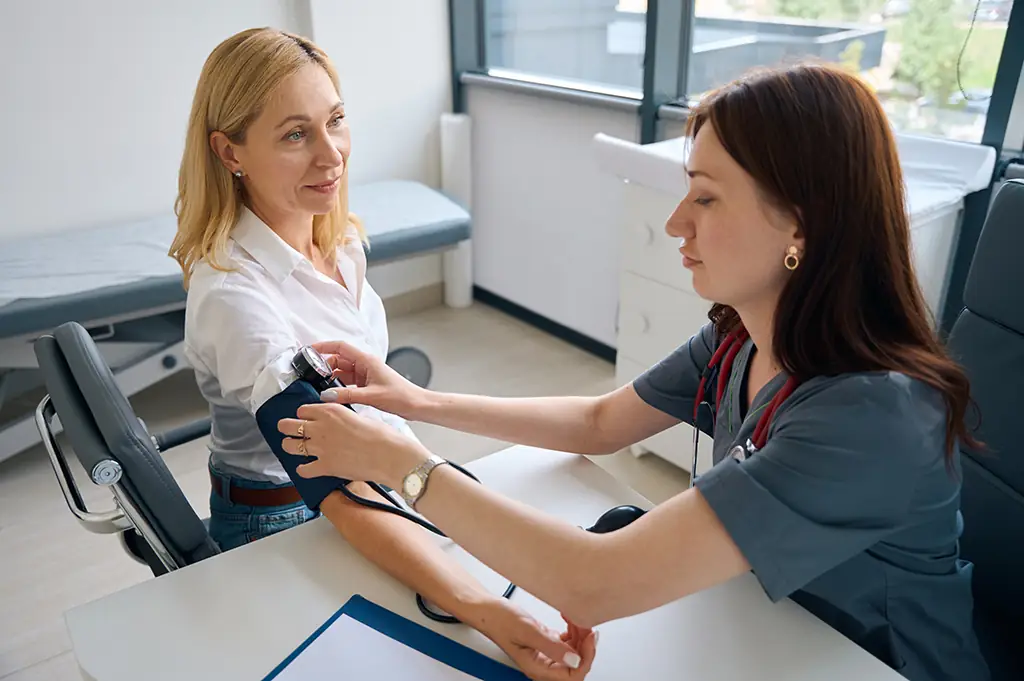
Imageplotter / Alamy Stock Photo
Thursday 3 July 2025
16:45 — Headlines from NHS ten-year plan launch
- Pharmacists to take on expanded clinical roles — community pharmacy will shift toward clinical services, supporting long-term conditions, prevention, prescribing and vaccination as part of neighbourhood care teams
- Genomics and national formulary reforms announced — routine genomic testing will begin from 2026; a single national formulary will replace local lists within two years, with NICE to phase out non-cost-effective treatments.
- Workforce plan pledged for autumn — health secretary Wes Streeting confirmed a new NHS workforce plan will be published in autumn 2025, with revised staffing projections and a focus on new tech driving “big productivity gains”.
- MPs seek clarity on funding and delivery — cross-party MPs broadly welcomed the plan but raised concerns over resourcing, inflation, staffing and implementation of neighbourhood health centres.
- Neighbourhood health centres to open — 250–300 centres planned by 2035, including 40-50 in this Parliament. NHS-run ‘one stop shops’ will operate 12 hours a day, 6 days a week, with possible private investment in infrastructure.
- NHS App to integrate AI and genomics — by 2028, the app will guide patients to appropriate services, manage medicines, integrate genomic data and enable proactive care and personalised support.
This marks the end of today’s coverage of the NHS ten-year plan. Join us again tomorrow for the latest headlines and reactions and let us know your thoughts in the comments.
16:30 — Reactions from pharmacy bodies so far
The first reactions from pharmacy bodies are in, including:
- Janet Morrison, chief executive of Community Pharmacy England: “Whilst we welcome the changes for community pharmacy in this plan, we are keen to start discussing the practicalities as soon as practicable. The development of each new service needs to be carefully managed given the sector’s current capacity and tight finances.”
- Henry Gregg, chief executive of the National Pharmacy Association: “The devil’s in the detail but there is a lot of opportunity for community pharmacy contractors having a vital role in the Neighbourhood Health Service – bringing health to the heart of the high street.”
- Gisela Abbam, chair of the General Pharmaceutical Council: “We would urge the UK government to make sure that pharmacists, pharmacy technicians and pharmacies are closely involved in developing and delivering the plans around the Neighbourhood Health Service, so their expertise can be used to help achieve this significant shift in how healthcare is delivered.”
- Leyla Hannbeck, chief executive of the Independent Pharmacies Association: “If pharmacies are to take on more responsibilities … then proper funding must be in place beforehand so we can plan, train and invest to give our patients the level of service and support they deserve.”
13:55 — Health secretary pledges autumn workforce plan
- At a discussion in Parliament after the launch of the ten-year plan, shadow health secretary Ed Agar asked how the plan would be paid for without funds “being eaten by pay rises and by inflation”, as well as “how the shift will be staffed”. In response, Wes Streeting, health and care secretary, said that new technology would drive “big productivity gains in the system” that had previously not been available.
- Streeting also said the government would set out a new workforce plan that aligns with the ten-year plan “this autumn”.

Shutterstock.com
12:15 — Technology and genomics
- NHS app to use AI to send patients to pharmacies — the government has announced a new AI-enabled tool within the NHS App, called “My NHS GP”, which will be introduced by 2028. This will help direct patients in need of non-urgent care to the most appropriate source, including a community pharmacy.
- Increased use of robotics in dispensing — the government said it would “scale the use of robotics in pharmacy. where they can fill prescriptions far more quickly and accurately than humans”.
- Genomics expansion from next year — genomics will be integrated into routine practice, with neighbourhood health staff equipped to provide genomic counselling.
- A unified genomic record, integrating genomic data with relevant clinical and diagnostic data, will be linked to the single patient record. This could be used to shape personal care plans for those with a long-term condition, or deliver personalised health coaching, recommend healthier choices and provide reminders and alerts to participate in risk stratified screening and other diagnostic tests, through the NHS App.
- NHS app will include pharmacogenomics and drug interactions — another tool within the NHS app, ‘My Medicines’, will, in the short term, help patients manage repeat prescriptions for delivery or collection, and remind patients what medicines they need to take and when. In the long term, it will be able to guide patients on drug interactions, integrate pharmacogenomic data and help avoid adverse reactions.
- Pharmacogenomics integrated into NHS health check from next year — from next year, the government “will work with clinical experts to integrate genomic testing for pharmacogenomic profiles into the NHS over-40s Health Check”, and over time, will “make this a universal offer”.
- Integrating pharmacogenomic insights in mental health prescribing “will also be a priority”, it said.
- Also from next year, the NHS will begin integrating genomic insights into cardiovascular disease prevention and care through a trial with Our Future Health. Integrated Risk Scores (which bring together genomics and other non-biological risk factors) will be used by neighbourhood health services, and subject to evaluation, this could expand more widely to include other conditions, such as diabetes, breast, bowel and prostate cancer, and dementia.
- Expansion of genomic testing for cancer and cardiovascular disease — this will be underpinned by an expansion of population health testing within the NHS Genomics Medicine Service, and of the NHS’ whole genome sequencing programme. In particular, genome sequencing will focus on risks relating to common disease areas, including cardiovascular, renal and diabetes. Genomic testing for inherited causes of major diseases will be expanded, including cancer (e.g. BRCA1/2 genes), and cardiovascular disease predisposition (e.g. familial hypocholesteraemia).
- Every cancer patient to access genomic profiling to guide treatment, if they want — under the plan, every cancer patient will have the choice to receive a comprehensive genomic analysis and molecular profiling to guide precision treatment decisions. Liquid biopsy technology will also be used to enable non-invasive early detection of disease and monitor treatment response.
12:00 — Neighbourhood health services
- Pharmacists will have a “vital role” in neighbourhood health services under the plan.
- These services are intended to bring more care into community settings, end “fragmentation” of health care and make it easier for patients to access, and navigate, the range of NHS services.
- “If the NHS does not feel like a single, coordinated, patient-orientated service, that is for a simple reason: it is not one”, the plans says.
- “It is hospital-centric, detached from communities and organises its care into multiple, fragmented siloes. We need to shift to provide continuous, accessible and integrated care.”
- Under the plan, every community in England will have a neighbourhood health centre – multidisciplinary “one stop shops” that will be open for 12 hours a day, six days a week. They will initially be placed in areas where healthy life expectancy is lowest.
- The essential role of pharmacy in neighbourhood health services is the “direction of reform in other countries and there is much we can learn. For example, Canada’s ‘Pharmacy Care Clinics’ provide services including support with minor ailments through to chronic disease management”.
- “As well as improving patient choice and convenience, there is now strong evidence that a bigger role for pharmacy can deliver efficiencies and support financial sustainability.”
- Neighbourhood services will have “significant licence to tailor the approach to local need”.
- The plan also says that over the next five years, community pharmacy will transition from “being focused largely on dispensing medicines to becoming integral to the neighbourhood health service, offering more clinical services”.
- Highlighting the increasing number of pharmacist independent prescribers, the plan envisions pharmacists taking a greater role in supporting patients with long-term conditions, obesity, high blood pressure, high cholesterol and “complex medication regimes”.
- The plan notes that there are areas where multidisciplinary local care is already working, and says that “in many areas, the existing primary care network (PCN) footprint is well set up as a springboard for this type of working”.

Shutterstock.com
11:05 – Updates at a glance
- Government launches ‘Fit for the future: ten-year health plan for England‘ at a hospital in East London.
- Community pharmacy will get access to single patient record — the ten-year plan has promised to increase the role of community pharmacy in the management of long-term conditions and link them to a single patient record.
- Five year plan to integrate pharmacies into clinical neighbourhood teams — over the next five years, community pharmacy will “transition” from “being focused largely on dispensing medicines to becoming integral to the neighbourhood health service, offering more clinical services”.
- Community pharmacies to deliver HPV jabs — from 2026, community pharmacies will deliver HPV vaccinations among young people who have left school.
- Government to increase community pharmacists’ role in management of long-term conditions — as community pharmacists increasingly become prescribers, the government will “increase their role in the management of long-term conditions, complex medication regimes, and treatment of obesity, high blood pressure and high cholesterol”.
- Pharmacists to have bigger role in prevention — “We will also give community pharmacy a bigger role in prevention by expanding their role in vaccine delivery and in screening for risk of cardiovascular disease and diabetes,” the plan says.
- The NHS App will give patients control over a single patient record and, by 2028 will be “a full front door to the entire NHS” that allows patients to:
- “Get instant advice for non-urgent care, and help finding the most appropriate service first time, through My NHS GP”;
- Hold consultations through the app with My Consult;
- Book tests and vaccinations, manage their medicines and long-term conditions;
- Access approved digital tools;
- Leave feedback on the care they have received.
- The app will use “continuous monitoring to help make proactive management of patients the new normal, allowing clinicians to reach out at the first signs of deterioration to prevent an emergency admission to hospital”.
- Expanded access to weight-loss jabs — the government also promised to “harness recent breakthroughs in weight loss medication and expand access through the NHS”, and “negotiate new partnerships with industry to provide access to new treatments on a ‘pay for impact on health outcomes’ basis”.
- Vaccinations and screening — the plan has pledged to increase uptake of human papillomavirus (HPV) vaccinations among young people who have left school, as well as to “fully roll out” lung cancer screening for those with a history of smoking.
- The government also said it would create “a new genomics population health service” accessible to all, by the end of the decade. In addition, universal newborn genomic testing and population-based polygenic risk scoring will be implemented alongside other emerging diagnostic tools, enabling early identification and intervention for individuals at high risk of developing common diseases, the government said.
- Move to single national formulary within two years — the ten-year plan has set out the government’s intention to move to a single national formulary (SNF) for medicines within the next two years. A new formulary oversight board will be created, supported by the National Institute for Health and Care Excellence (NICE). Local prescribers will be encouraged to use products ranked highly in the SNF but will retain clinical autonomy as long as they prescribe in line with NICE guidance, the government said.
- According to the 10 year plan, this is response to the “needlessly complicated” system currently in place, with local formularies creating “a postcode lottery”.
- NICE to retire non-cost-effective drugs – drugs that are no longer cost-effective could be retired, with NICE to “re-evaluate priority clinical pathways on a rolling basis”.
- NHS compliance with NICE decisions will be linked “to core clinical standards, best practice tariffs and incentives”, the government said.
- From April 2026, the Medicines and Healthcare Regulatory Agency (MHRA) and NICE will “launch a new joint process, supported by information sharing and joint scientific advice, that will boost the speed of decisions and cut administrative burdens for the system and industry.”
Wednesday 2 July 2025
22:30
- Prime minister Keir Starmer announces major themes of the NHS ten-year health plan, due to be published on 3 July 2025, saying that its approach was “rebalancing our health system so that it fits around patients’ lives, not the other way round”.
- Under the plan, pharmacists will work as part of ‘neighbourhood health teams’ alongside other healthcare professionals.
- Other pledges include the end of “status quo of ‘hospital by default’”, and the promise of “a new preventative principle that care should happen as locally as it can: digital-by-default, in a patient’s home where possible, in a neighbourhood health centre when needed, in a hospital if necessary”.


